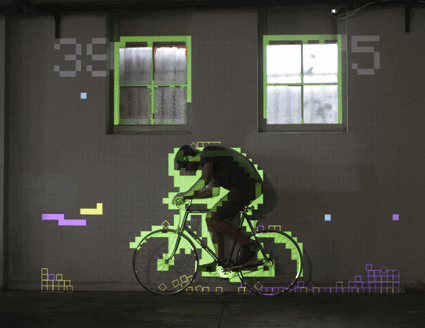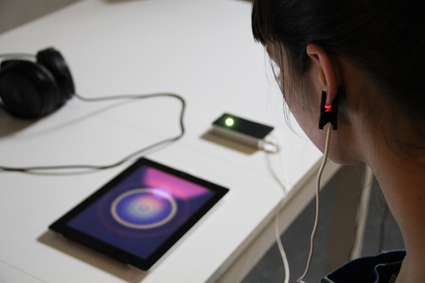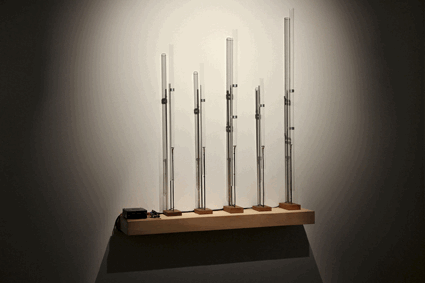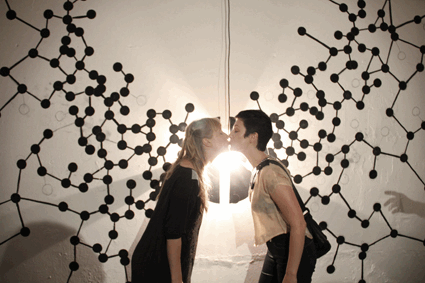media art diy: clefts & crevices
dan mackinlay: dorkbot group show 2012, serial space

Mobile Projection Unit, Snake the Planet!
courtesy the artists, opening night photo Kate Blackmore
Mobile Projection Unit, Snake the Planet!
THE BACK WALL OF SERIAL SPACE IS FILLED WITH A PROJECTION OF A VIDEO GAME, SNAKE THE PLANET!, EMITTED FROM A TARTAN SHOPPING ‘JEEP’ (TROLLEY). IT HAS THE STUDIED INFORMALITY OF A GRAFFITI RESEARCH LAB PROJECT (SEE RT103), COMPLETE WITH TITLE IN THE ROUSING IMPERATIVE.
The casual flavour is more potent as the background of its creators, Lukasz Karluk, Rene Christen and Nick Clark (aka Mobile Projection Unit, http://mpulabs.com) who have between them worked on enough high-budget commercial interactives that it is clear they could have opted for a more seamless and slick surface. But for now they are all about insinuating themselves into the crevices.
The game is a homespun version of the arcade classic Snake, whose pixellated arena weirdly traces the shapes of the wall itself. Documentation shows the shopping jeep in the company of a ragged sofa and assorted living room furnishings, touring down back alleys and culs-de-sac, resting, it seems, in this most back-alley of galleries before the tour continues. It’s the enactment of an anecdote from writer and activist Jane Jacobs or social theorist David Harvey on the multiple uses of the sidewalk, but here we’re meshing those earlier democratic urban visions with the arcade games of the creators’ childhood milieu. Or, if you like, claiming that earlier politics for the armchair video game generation questions the idea of such games as a cause of urban alienation, countering with an 8-bit social urbanist manifesto for the next wave of space invaders.

George Khut, Distillery II
photo Kate Blackmore
George Khut, Distillery II
Tracing a different history is George Khut’s piece, Distillery II. Khut’s oeuvre sketches in miniature the evolution of computing machinery, from primordial campus behemoths to the portable experience of modern ubiquitous computing.
The core theme throughout is biofeedback. In Distillery II your physiological signals are translated into minimal, asymmetric rings of brightness on an iPad display, the unconscious processes of life made explicit and external. The hook is the visceral way you have to buy in to the work in order to experience it. If you have taken the time to use the machine’s help to change your very heart rate, then it is a contradiction to claim being unaffected.
As raw as this avowed prototype is, it is more polished than its progenitor works, say, Cardiomorphologies v2 from 2007. In that piece the retrofuturist reclining couch recalled ancient room-filling supercomputers, but this iteration, given the tenor of the moment, is necessarily on iPad app. Your heart-rate is measured by a slimline slip-on ear-ring, the visualisations displayed on a solipsistically personal screen.
One day, Khut explains, this experience could be in sundry app stores; he just needs to work out how to get decent biometric data into the phone. And with that, it looks different to me: not so much a feature on the underground terrain of new media art, rather a niche consumer item on the mainstream landscape: a takeaway meditation aid for the modern yogi-on-the-go.
This is not to dismiss it for mass-marketability—the opposite, really. Distillery II is elegant and more minutely worked than the typical eye-candy on your smartphone app-store of choice. The distinctive lines of the portable Apple fetish item do invite us to consider the relationship to Angry Birds and all the other virally unsociable fruit of this decade’s commuting habits. There is nothing wrong with exhibition as focus group, although I think the exhibition opens me to a work that would be invisible on an app-store promotion page—it’s the physical presence of the artist as he greets me that tells me to set that time aside

Paul Greedy, Untitled (Air 1)
photos courtesy the artist
Paul Greedy, Untitled (Air 1)
The show is not all software, by any means. Hands cupped at the other end of the industrial metabolism, Peter Blamey has made another RF-interference sound work from what he could catch—a new copper wire and discarded circuit-board sound installation (see e-dition Aug 23). And, conspicuously handcrafted, Paul Greedy shines for minimalism in form and function. Untitled (Air 1) is made of heating coils couched austerely in lengths of glass piping. They sing in turn, with heat-induced resonance, driven by a tiny Arduino (open-source electronics circuit board). If he wanted to make the contrast with the more computer-heavy works complete, he could have discarded the few integrated circuits entirely for pre-transistor relays.

CJ Conway, i am so into you
vertical photo courtesy the artist; horzontal photo Kate Blackmore
CJ Conway, i am so into you
Instead, the prize for simplicity (there are prizes for this, right?) goes to CJ Conway, even as the literal way that she brings people together has her in with a chance for the community-space awards as well. Her work, i am so into you, is a monochrome inflorescence—a design sketched in graphite onto the bare gallery wall, cleft in the middle to allow for a naked incandescent bulb. That bulb glows when you touch both sides of the sketched shape at once, closing the circuit. The next question, of course, is can you and another person touch one side of the work each and still light the bulb? Curator Pia van Gelder and I stand with our palms to the wall to find out. But the bloody thing won’t activate just for a fingertip touch; we have to interlock fingers.
Dorkbot Group Show 2012, curator Pia van Gelder, artists CJ Conway, George Poonkhin Khut, Peter Blamey, Paul Greedy, MPU (Mobile Projection Unit): Lukasz Karluk, Rene Christen, Nick Clark, Serial Space, Chippendale, March 6 -11; www.serialspace.org
This article first appeared as part of RT’s online e-dition march 20.
RealTime issue #108 April-May 2012 pg. 22






